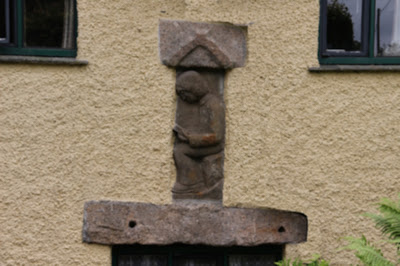George was
born on 2nd September 1895 at Tregrove in Linkinhorne, the only son
of George and Beatrice Mary Brock. He was baptised on 15th September 1895 at
Calstock church. By the time of the 1901 census (31st March 1901)
the Brock family was living in Stoke Village, presumably in Lower Town where
his parents ran a small sweetshop/grocery shop. They were at the same place when the 1911 census was taken (3rd April 1911) and George, at
age 16, is listed as being an apprentice blacksmith. George’s parents later
moved to 3, Moss Side, Callington.
Sometime
after this George moved to Dursley in Gloucestershire where he was employed
in the Zone Works of Mawdsley’s, a large manufacturer of electrical machinery. He
may have been one of the many people attracted to the area to work at either Mawdsley’s
or R.A. Lister’s. He lodged in Woodmancote, a part of Dursley, and was a
regular member of the congregation of St. George’s Church in Upper Cam (a
village adjoining Dursley). He was
described as a “splendid, willing worker
and a nice young fellow with many local friends".

George enlisted into the
Gloucestershire Regiment in Dursley at a recruiting meeting held in the
R.A. Lister Mess Room on 3rd September 1914. The Regiment was raised from men in
the Bristol area as part of Kitchener's Second New Army and
joined the 57th Brigade in the 19th (Western) Division. They trained at Perham Down on
the edge of Salisbury Plain in Wiltshire and in March 1915 moved to Tidworth
for final training. The battalion embarked for France and
Flanders on 18th July 1915, the date appearing on George’s Medal Roll Card as
the date he entered the France and Flanders Theatre of War. The Division concentrated near St Omer. Their first
action was at Moulin du Pietre on 25th September, which was a
diversionary action supporting the Battle of Loos. It was designed purely to pin down German
reserves and serve as a diversion from the main engagement at Loos. But it was
perhaps on the smallest scale of any of the holding actions. All that was hoped
from it at best was the capture of the German front-line trench upon a front of
about 1,200 yards, after which it was intended to join it up to the existing
British line. In order to allow the consolidation of the front line, when
taken, the second line was also to be captured, and the troops withdrawn as
soon as the front had been put into a state of defence.
In the summer
of 1916 they were involved in the Battle of the Somme. Although held in reserve
for the first day – 1st July – they, as part of the 19th
Division, were put into the attack on 2nd July. They attacked south of La
Boisselle, using a ruse of bombarding Ovillers in order to confuse the Germans.
By 15.30 some of the men had bombed their way into the village; this led to
some severe house-to-house fighting with the German defenders, and the village
was eventually taken the following day. Counter-attacks from the Germans had to
be fought off and only by 5th July could the village be said to be safely in
Allied hands.
An extract from
the War Diary of the 8th Gloucesters reads:
July 3rd 1915: Location Tara-Usna Line
1.30 am: Moved forward to attack via St Andrews Trench
3.15 am: Attacked La Boiselle and consolidated position. Remained there all day
and night. Officers killed: Capt. H.Cox, Capt, E.H.Crooke, Capt. W.J.Mason, 2nd
Lt. E.J.Evans, 2nd Lt. F.J.Gadney, 2nd Lt. G.E.H.Ross.
Elsewhere in the diary are given the official casualty figures for the action:
Officers killed: 6; Officers wounded: 14; Other ranks killed, missing or
wounded: 282.
George Hoskin
Brock was one of the men missing and his body was never recovered. He is commemorated on the Thiepval Memorial. Pier and Face 5 A and 5 B. As well as the Stoke Climsland War Memorial, George is also
remembered on memorials in Callington, where his parents subsequently lived,
and Dursley in Gloucestershire, where he enlisted into the army.
A notice about his death appeared in the Cornish and Devon Post on 22nd
July 1916. It reads “Private George
Brock, who has been reported killed in action, was another old boy of Stoke
Climsland Council School. The teachers and scholars of his time as well as the
villagers will ever remember George with affectionate regard as a boy of
remarkable integrity and sweet disposition. Sympathy is felt for his parents
and it is hoped that his splendid character and soldierly bearing will be an
example for many a youth in the parish to emulate”.
Another notice appeared on the anniversary of his death (July 3rd
1922) in the Western Morning News. It read “BROCK.
In fond and ever-loving memory of Pte. George Hoskin Brock, Sig. Batt. 8th
Gloucester Regt., who gave his life for King and country in France, July 3rd,
1916, aged 21 years, the only darling son of George and Beatrice M Brock, 3,
Moss Side, Callington”.



















































